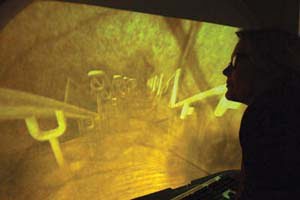
Harnessing Technology to See
Elizabeth Goldring, a senior fellow at MIT’s Center for Advanced Visual Studies in Cambridge, Mass., and visually impaired herself, has spearheaded the development of a seeing machine. She has worked with physicians, technical developers and fellow students to pare down the technology of a specialized diagnostic device to create a tool that enables her to see words, images and other visual information.

Elizabeth Goldring looks at a picture she created to approximate what she sees when she views an image of a staircase through her retinal imaging system. Photograph by Donna Coveney.
Her inspiration started years ago at Schepens Eye Research Institute in Boston, where she had her vision tested with a scanning laser ophthalmoscope. When a simple word was projected directly onto her retina, she was able to see it — the first word she had been able to read in months. She later found that she could use the device to view images and as a navigational aid — for previewing unfamiliar rooms to acquaint herself with the layout of entrances, exits, stairs and structural elements.
However, the device not only was large and unwieldy, but also had a six-figure price tag. Robert H. Webb, the institute scientist who invented the scanning laser ophthalmoscope, suggested that a simpler device could be made at a fraction of the cost and would eliminate the diagnostic functions but meet her visual needs. What the team has developed is a desktop setup called a retinal imaging machine vision system, which comprises a projector, a computer, a monitor and a joystick, and which has a price tag of about $4000. It has replaced the laser light source with LEDs and passes the collimated light through an LCD to focus it in the center of the pupil, enabling the full extent of the light to reach the retina.
Goldring recently conducted a pilot clinical trial of the device with 10 severely visually impaired subjects. The majority of participants were able to see images, to understand the pictograph shorthand that she had created to increase recognition and to use the device to explore visual environments. Many also felt that seeing images helped them remember content.
Next, Goldring and her colleagues would like to initiate a large-scale trial in the hope of attracting interest in commercializing the technology. Eventually, she would like to make it accessible to a large number of people; for instance, in libraries.
Way down the road, one could even imagine a portable device — such as a pair of virtual reality glasses, Webb added.
This is a notable example of what can happen when need and technology are paired in pursuit of a common vision.
/Buyers_Guide/American_Air_Water_Inc/c657